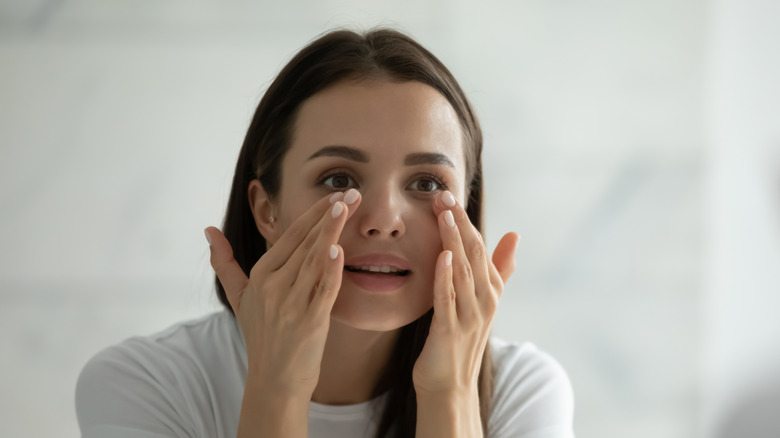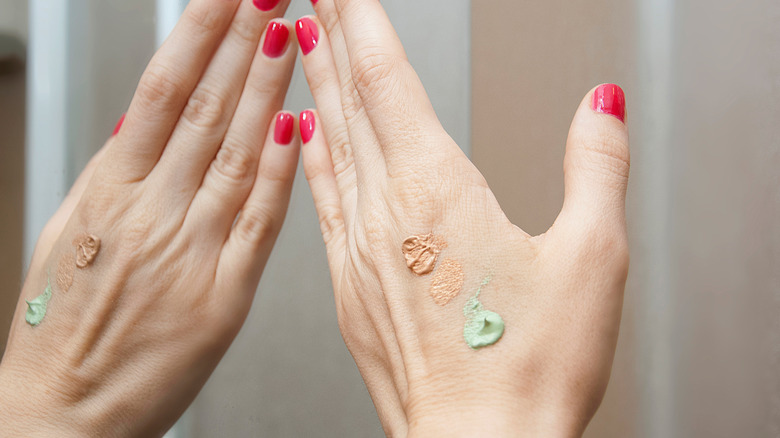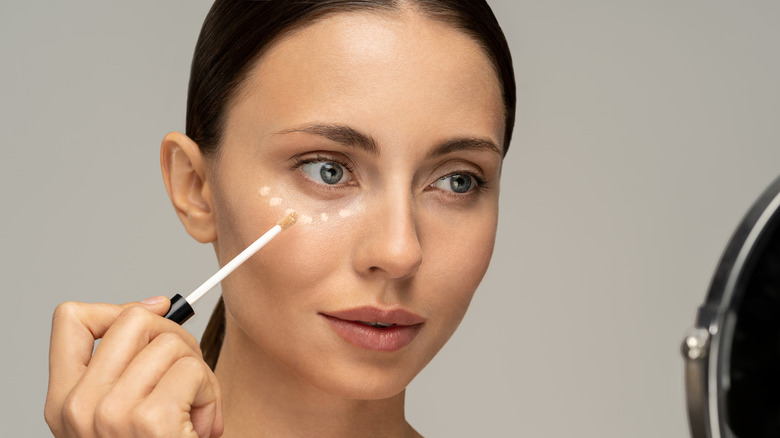The Two Colors To Combine To Correct And Brighten Your Dark Under-Eye Circles
Let's face it, we've all dealt with one form of under-eye issues or another. Whether it's dark or dry under-eyes, there are a lot of things that can go wrong here. Even applying regular concealer can end up being useless if the problem persists. If you have dark circles, a regular concealer isn't enough to cover up the area, and in just a few hours, your dark circles can present themselves again. The truth about dark under-eye circles is that it's much more than just a lack of sleep. Cleveland Clinic explains that various factors can cause dark circles, including family genetics, dehydration, and hyperpigmentation. A hollowed area and shadows can cause this area to appear blue or black and give meaning to the name "dark circles."
One of the few ways to cover up this area is with the help of color-correcting products. Color-correcting concealers, for example, are a common way that many beauty lovers hide blemishes and other skin issues for a flawless appearance. Using basic color theory, color correctors can disguise almost any skin issue by playing with various pigments. Knowing which shades to hide these imperfections can be a pain point for many and might be why some don't use this tool. For your under-eyes, the solution simply calls for mixing two colors, and you can quickly get a night's sleep in about five minutes.
Color-correcting dark circles
Before picking up your color correctors, quickly examine your dark circles. Most dark circles will have a blue tint to them, meaning you will need to cancel it out with the color opposite to it on the color wheel. An orange color corrector will help conceal the blue and get your under-eyes looking closer to your skin color. However, the exact shade of orange will depend on your skin tone. As Hide explains, those with paler skin tones should reach for a peach concealer, while those with medium to dark tones will work best with orange color correctors. A bisque color corrector will cancel out the blue best if you are within light to medium skin tones. Once you've applied the orange color corrector, you can work to brighten up the area.
Yellow color correctors are an excellent addition to your color-correcting routine if you have a few purple veins in your under-eye area. Being opposite of purple in the color wheel, yellow color correctors can help neutralize purple bruises, veins, or discolorations. As well as concealing these purple spots, yellow concealer can help brighten up the under-eyes and make it appear like you always get your full eight hours of sleep. Mixing these color correctors can help turn your dark circles around and give you a healthy glow.
The right way to use color correctors
Using color correctors isn't as easy as swiping the product across the under-eye and brushing it in. Like regular concealer, color correctors have their technique to get a flawless application. Foreo recommends using a makeup sponge instead of a brush to tap the product in place. With a brush, you'll move the product around into areas that don't need it. Also, a makeup sponge can get you a more targeted application to concentrate the product on specific zones. Because you'll use it on particular spots, you don't need to apply a thick layer to mask it. Spread thin coatings at a time to avoid overapplying and prevent your concealing from looking cakey. Typically you'll find that a small amount can go a long way with your color correctors.
When applying your color corrector, you want to use it before putting on your foundation. Placing your foundation on top of your color corrector will help the product stay in place throughout the day. When applying your foundation, pat it in the areas you've used the color corrector. Swiping the foundation on top will simply move the pigment of the color corrector around and ruin your work. If you need more coverage, layer your regular concealer over your foundation. You can get the full-coverage look with a neutralized under-eye area between the color corrector, foundation, and regular concealer.


